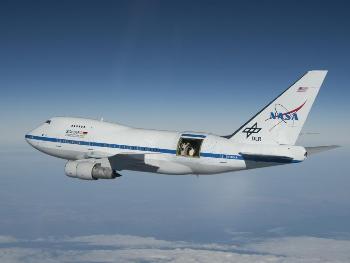May 7 2013
Constance Gartner first heard about NASA’s SOFIA (Stratospheric Observatory for Infrared Astronomy) from her students at the Wisconsin School for the Deaf in Delavan, Wis.
 With the large door over its 2.5-meter German-built telescope wide open, NASA’s Stratospheric Observatory for Infrared Astronomy 747SP aircraft soars over Southern California’s high desert during a 2010 test flight to prepare for early science missions. SOFIA conducts astronomical science flights at altitudes of up to 45,000 feet. Source: NASA photo / Jim Ross
With the large door over its 2.5-meter German-built telescope wide open, NASA’s Stratospheric Observatory for Infrared Astronomy 747SP aircraft soars over Southern California’s high desert during a 2010 test flight to prepare for early science missions. SOFIA conducts astronomical science flights at altitudes of up to 45,000 feet. Source: NASA photo / Jim Ross
Her students participate in programs developed at the University of Chicago’s Yerkes Observatory in Williams Bay, Wis. that make astronomy accessible to students who are blind, visually impaired, deaf, or hearing impaired.
During visits to the observatory, Gartner learned that Yerkes scientists were building SOFIA’s High-Resolution Airborne Wideband Camera. “I was very intrigued by the opportunities that were available for educators and SOFIA,” said Gartner, director of curriculum and instruction at the School for the Deaf.
NASA makes these opportunities available through SOFIA’s Airborne Astronomy Ambassadors program. Gartner was among SOFIA’s first Airborne Ambassadors, along with Chelen Johnson, a science teacher at Breck School in Golden Valley, Minn., and two other teachers. All four educators participated in SOFIA research flights out of Palmdale, Calif., on the nights of Feb. 12 and 14.
SOFIA is a 747 jet modified to carry a 100-inch infrared telescope built into its fuselage. Scientists use the infrared data that SOFIA collects to study the formation of stars and planets; the chemistry of interstellar materials; the composition of comets, asteroids and planets; and the galactic environments of supermassive black holes.
“I applied for SOFIA because I have been working with infrared and radio data for many years,” said Johnson. “SOFIA was a new opportunity to extend previous projects.”
Johnson is sharing data gathered on the flight with her Saturday Astronomy Club and her astronomy students. She is talking to her students about pursuing STEM (science, technology, engineering and math) careers and encouraging them to follow their dreams. “Flying aboard SOFIA was an exhilarating experience, one that I will remember for the rest of my life,” Johnson said.
Johnson had served as a mentor teacher to Gartner on a previous project. SOFIA requires teachers to apply in pairs for the ambassadors program, which provided Johnson and Gartner another opportunity to work together.
“In American Sign Language, many astronomy terms do not necessarily have a corresponding ASL sign,” Gartner said. “It’s critical for teachers and interpreters to understand the concepts in order to explain and interpret topics like astronomy and astrophysics, as well as other terms related to STEM. Chelen helped me understand this so I could support our students better on this project.”
HAWC to fly
Yerkes scientists focus much of their work on education outreach and infrared astronomy, which helps familiarize teachers with SOFIA operations. Yerkes engineers built the High-Resolution Airborne Wideband Camera, a project led by Al Harper, professor in the Astronomy & Astrophysics at UChicago, in collaboration with scientists at NASA’s Goddard Space Flight Center and the Rochester Institute of Technology. The camera is scheduled for delivery to NASA this month and will fly aboard SOFIA in 2015.
Yerkes astronomers also show teachers how to present classroom material in a hands-on way. Vivian Hoette, Yerkes director of education and outreach, was especially active in helping the teachers prepare for their flights.
“All ambassadors were required to take an online graduate-level astronomy course,” Gartner said. “For me, that was quite challenging because I was in the middle of finishing my dissertation, but I had tremendous support from Chelen, Viv and some of my other colleagues and astronomers from Yerkes.”
After completing their initial course in May 2012, the teachers took a shorter online course to learn about SOFIA and its goals.
Pre-flight activity
“Prior to the initial flight, we had safety training, and then we spoke with several mission specialists and ground support personnel,” Gartner said. “Our role was to observe, ask questions, learn about the programs on the educator computers, and provide feedback to the software programmers on how to improve the educator experience.”
Gartner’s dream is to bring other deaf and hard-of-hearing teachers into NASA programs generally, and SOFIA specifically.
“Our charge as ambassadors is to go out and spread the word to our communities about this program. My first goal is to share my experience with local and state deaf communities,” Gartner said. She also would like to introduce the local deaf community to more Yerkes programs.
“Nothing would please me more than seeing our deaf and hard-of-hearing students pursue STEM career paths as a result of their experiences at Yerkes,” Gartner said.
— Katherine Watson